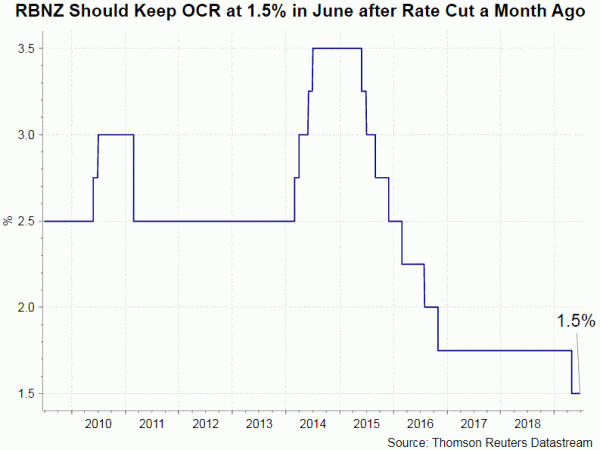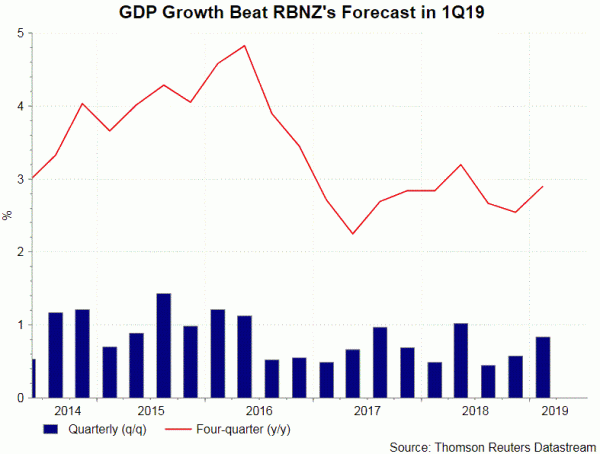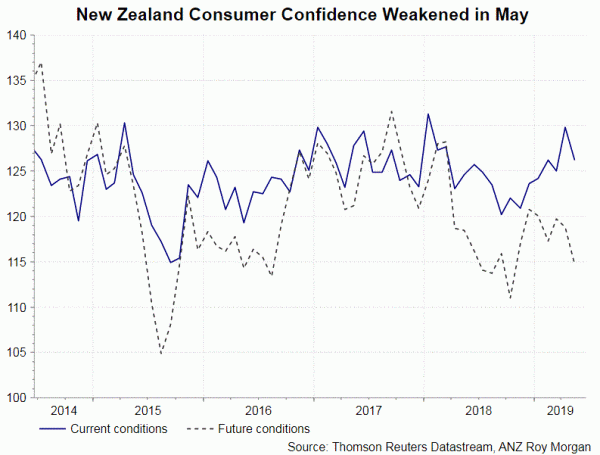After lowering the policy rate by -25 bps to 1.50% in May, RBNZ would likely remain on hold this month. Domestic economic developments came in largely consistent with policymakers’ projections. Yet, global economic outlook remains uncertain and major central banks have recently shifted their stance on the dovish side.
As such, we expect RBNZ to maintain a cautious tone in June. Softness in leading indicators signal risks to growth are skewed to the downside, paving the way for further rate cuts later this year.
Mixed Domestic Economic Developments
GDP expanded +0.6% q/q in 1Q19, beating RBNZ expectations of +0.4%. The details were mixed. Household consumption growth eased to +0.5% q/q, from +1% in the prior quarter. Investment growth, however, accelerated. Residential investment expanded +2.7% y/y, following a +1.9% growth in 4Q18, while other fixed asset investment growth also accelerated to +1.9% q/q. from +1.4% in 4Q19. Moreover, net exports expanded +0.6% q/q n 1Q19, up from +0.4% in the previous quarter. Sector-wise, the good-producing sector gained a solid +2% q/q. However, growth in services activities was soft at +0.2% q/q and mixed across the industries, while the primary sector saw contraction of -0.7%.q/q.
Leading indicators have signaled downside risks to domestic growth. ANZ Roy Morgan’s consumer index showed decline in May, while the manufacturing PMI (by BusinessNZ) fell to 50.2 in May, down -2.5 points from April and the lowest since December 2012. For the latter, the accompanying report indicates that it is “a warning signal for near term growth via its mix of falling production, near flat new orders, and rising inventory”.
Global Uncertainty and Dovish Central Banks
Globally, we do not expect immediate resolution on US-China trade war after the G20 meeting. At best, both sides would agree to resume negotiations. That is, uncertainty of trade war remains. Meanwhile, major central banks have shifted to the dovish side, signaling that future monetary policy stance is skewed to the easing side. RBA, after cutting the cash rate in June, revealed in the minutes that “more likely than not that a further easing in monetary policy would be appropriate in the period ahead”. Although the Fed left the policy rate unchanged in June, removal of the reference “patient” in the forward guidance could be paving the way for future rate cuts. Moreover, the median dot plots revealed that more members are in favor of lowering interest rates later this year, while the plots have projected a rate cut in 2020.
Although headline GDP growth beat RBNZ’s expectations, the breakdowns were mixed, at best. The forward-looking indicators, however, have signaled that risks to growth are skewed to the downside. Globally, it is unlikely that G20 summit this week would resolve the US-China trade war. Meanwhile, major central banks have either resumed accommodative monetary policy or hinted easing in the near-future. All these should lead the RBNZ to adopt a cautious tone this month, while opening the door for reducing interest rates again later this year.















